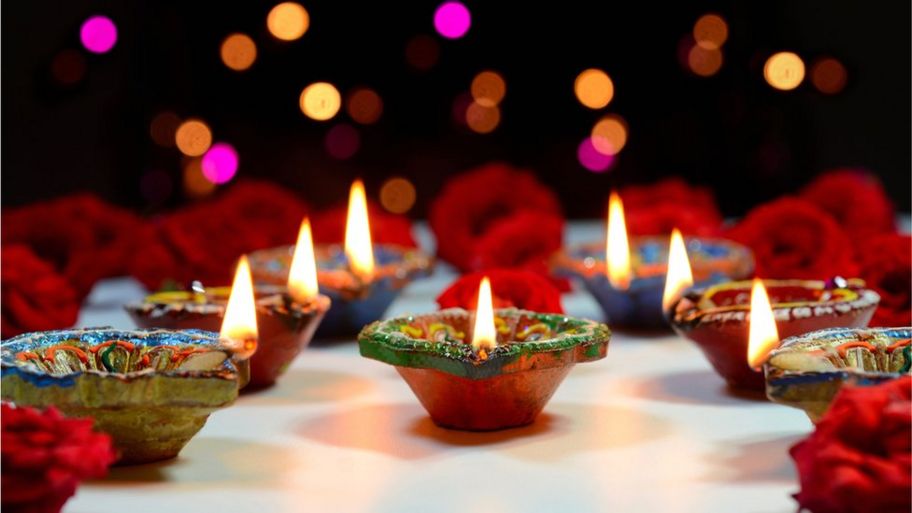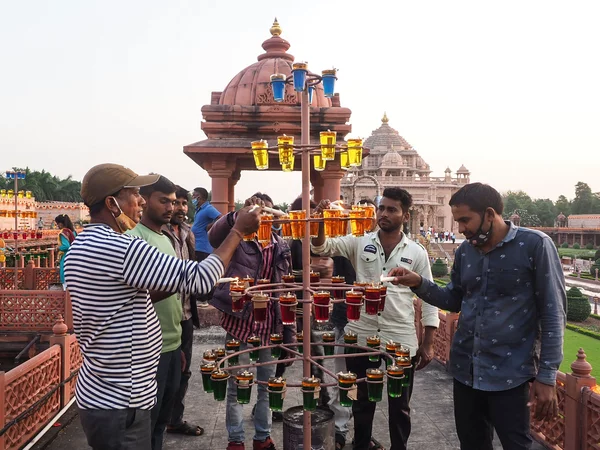


When an evil king in Lanka captures Sita, the wife of Rama (an incarnation of the god Vishnu), Rama “builds up an army of monkeys” to rescue her. The monkeys build a bridge over from India to Sri Lanka, and they invade Sri Lanka and free Sita and kill that evil king. As Rama and Sita return to the north, millions of lights are spread out across the city Ayodhya just to help them come back home, just to welcome them.
Lighting lamps has long been one of the ways that Hindus celebrate Diwali.


The name Diwali or Deepawali is derived from the row (avali) of clay lamps (deepa) Indians light outside their homes. These lights embody the inner light that protects Indians from spiritual "darkness". This centers around the Atman, a reference to a self-being that exists outside the physical body and is popularly manifested as an "inner light". The realization of one's Atman comes love, compassion for all, and attaining higher knowledge. This would then bring about Ananda, inner joy or peace.
Hindus celebrate the return of deities Rama and Sita to Ayodhya after their 14-year exile. They also celebrate the day Mother Goddess Durga destroyed a demon called Mahisha.
Sikhs particularly celebrate the release from prison of the sixth guru Hargobind Singh in 1619. But Sikhs celebrated the festival before this date.
In fact, the foundation stone of the Golden Temple at Amritsar, the most holy place in the Sikh world, was laid on Diwali in 1577.
The founder of Jainism is Lord Mahavira. During Diwali, Jains celebrate the moment he reached a state called Moksha (nirvana, or eternal bliss).
More than 1 billion Hindus celebrate and observe Diwali all over the world!


DAY ONE - Dhanteras
This is called the Festival of Purchasing Gold and Metals
People clean their homes and shop for gold or kitchen utensils to help bring good fortune.
DAY TWO - Choti Diwali
People decorate their homes and businesses with diya clay lamps and create design patterns called rangoli on the floor using colored powders or sand. These designs can take hours to make by hand.
Diya lamps have cotton wicks and oil, signifying the victory of good over evil in every individual.

DAY THREE - Diwali (Laxmi Puja)
On the main day of the festival, families gather together for Laxmi or Lakshmi puja, a prayer to Goddess Lakshmi, followed by mouth-watering feasts and firework festivities. Diyas (clay lamps) are lit at home and at businesses.
Fireworks on Diwali are a relatively new addition, starting in the 1950s after World War 2.
-1624866770.jpg?p=1024&s=a5dc5eb4fb13e1de35c012328dbf6c45)
DAY FOUR - Govardhan Pooja
This is the first day of the new year, when friends and relatives visit with gifts and best wishes for the season.
Prayers are also offered to Lord Govardhan and Shri Krishna (the 8th avatar of Vishnu and Supreme God).
DAY FIVE - Bhai Dooj
Brothers visit their married sisters, who welcome them with love and a lavish meal.
